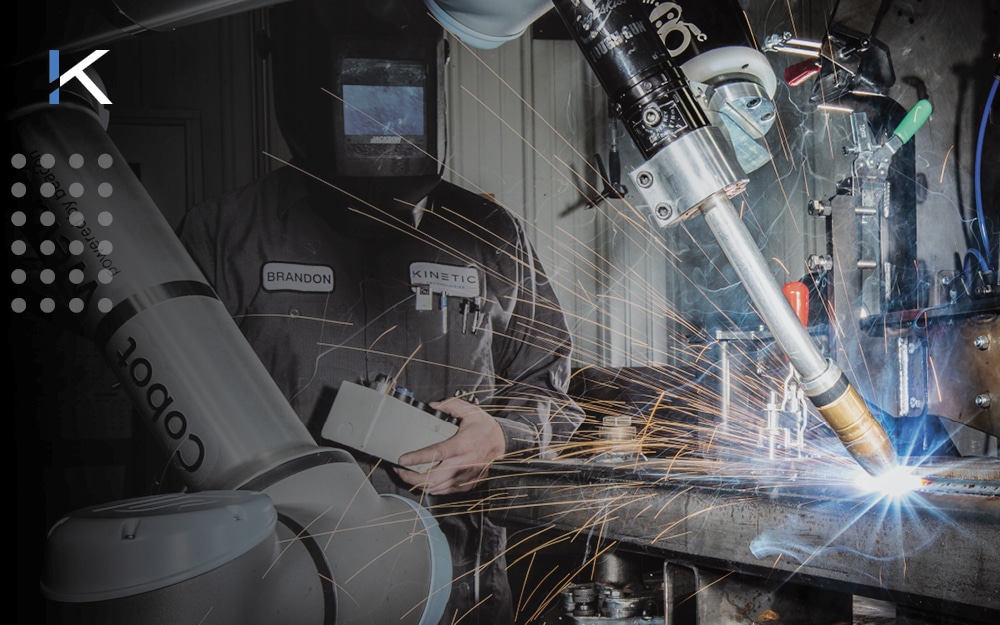
What Welding Robot Owners Should Know About Robotic Welding Fixtures & Positioners
1. Understanding Automated Welding Fixtures & Positioners
– The Importance of Precision In Automation Welding Fixture Design
2. The Role of Robotic Welding Fixtures & Positioners
– The Challenge For New Welding Robot Owners
– The Impact on Quality & Production
– Robotic Welding Fixture Benefits
4. Deciding on a Fixture Design Provider
– Factors to Consider When Outsourcing Fixtures
– Benefits of Outsourcing
Robotic welding systems represent a quantum leap in productivity and quality control. Yet, as any seasoned welding robot owner, production manager, or engineer can attest, these high-performance systems can also present challenges.
Perhaps you’ve watched a production run go off the rails due to inadequate fixturing or had to battle to maintain precision while managing complex part geometries. Maybe you’ve even experienced the frustration of time-consuming manual adjustments to accommodate different product configurations.
When these scenarios surface, it’s clear that changes in the manufacturing process are needed, and that’s where a precision fixture or positioner comes into play. These vital components are often overlooked but play a critical role in optimizing robotic welding operations.
In this article, we delve into the world of automated welding fixtures and positioners, helping you uncover the nuances of their utilization and maintenance while providing solutions to common problems. Take a step towards a more efficient, reliable, and high-performing robotic welding process today.
Understanding Automated Welding Fixtures and Positioners
Welding fixtures and positioners are specialized devices used in welding. Fixtures are designed to hold the workpieces securely in place and maintain their position during welding. Positioners manipulate the workpiece to present different sections to the welding apparatus, allowing for comprehensive and accurate welds.

Kinetic Technologies’ team working on a welding fixture and mounting it to their RT1 rotary positioner.
In the context of robotic welding, the role of fixtures and positioners becomes even more critical. Unlike manual welding, where a skilled welder can adjust the position of the torch or the workpiece in real-time, robotic welding requires consistent and precise positioning to achieve accurate, high-quality welds. The welding robot relies on predefined parameters and, hence, any positional inaccuracies can lead to significant defects in the weld.
The Importance of Precision in Automated Welding Fixture Design
Precision in the design of automated welding fixtures and positioners is vital. These components must be designed with high accuracy to ensure they align the workpiece correctly for the robot. As the robot follows a preprogrammed welding path, any inaccuracies in fixture design could cause the robot to weld in the wrong location, leading to poor-quality welds and increased rework. Hence, investing time and resources into the precise design of fixtures and positioners is critical for maximizing the efficiency and quality of your robotic welding process.
Key Takeaways
Robotic welding fixtures and positioners are crucial in welding automation. They help overcome common challenges welding robot owners face, such as managing large and complex parts, improving weld quality, and boosting productivity.
The Role of Robotic Welding Fixtures and Positioners
The Challenge for New Welding Robot Owners
As a new owner of a welding robot, you may face several challenges.
- Handling large and complex parts can be daunting, with areas the robot simply can’t reach.
- The design and manufacturing of custom fixtures might seem like a great solution, but it requires time and resources that you may not have.
- Specialized fixtures are needed for complex parts, adding to the difficulty of manufacturing.
- And when you try to integrate your existing manual fixtures into the robotic cell, they often fall short of the seamless synchronization required for efficient operation.
The Impact on Quality and Productivity
A well-thought-out fixturing strategy can significantly impact your production process. With inadequate or poorly designed fixtures, your welding robot could produce lower quality welds, slow down the overall production, and may require more manual intervention—negating the very benefits you sought with automation.
Robotic Welding Fixture Benefits
Increased Precision
Robotic welding fixtures and positioners ensure the workpiece is held in the exact position needed for the welding process, leading to more precise and consistent welds.
Enhance Productivity
Having the right welding fixture and positioner can optimize the welding process and increase weld time by reducing robot moves.
Reduced Rework & Waste
The improved accuracy and consistency brought about by using fixtures and positioners reduce the likelihood of errors, resulting in less rework and waste.
Improved Safety & Ergonomics
Fixtures and positioners help to stabilize potentially heavy or unstable workpieces and minimize pinch points, reducing the risk of accidents and creating a safer workspace. They also reduce the time operators are standing, reducing fatigue and allowing them to stay away from weld fumes and arc flash.
Versatility
With various types of fixtures and positioners available, they can be tailored to fit a wide range of welding tasks, from simple to complex workpieces.
Seamless Integration
Advanced fixtures and positioners can integrate seamlessly with your existing robotic welding systems, making implementation smooth and easy.
Optimized Welding Positioning
To ensure proper part fusion, weld puddle formation, and weld strength in manufacturing, adhering to specific weld positions as outlined in manufacturing weld prints is essential. These positions – flat, horizontal, vertical, and overhead – require precise alignment. A positioner is vital in achieving these precise positions to comply with the print requirements
The Different Types of Fixtures & Positioners
Understanding the different types of welding fixtures and positioners is crucial to optimize the performance of your robotic welding system. The choice depends on the complexity of the workpieces, the precision required, the volume of production, and the level of automation needed in your operations.
Let’s delve into the specifics of each type to help you make an informed decision.
Layout Templates/Jigs
Layout templates/jigs are simple, cost-effective solutions where the operator manually places and secures the workpiece in the fixture. They are typically used for simple weldments and low-volume production where high precision may not be a priority. However, these fixtures may not be suitable for complex weldments or high-volume production due to the potential for human error and slower processing times.
Semi-Automatic Fixtures
Semi-automatic fixtures are a step up from manual fixtures. These fixtures often include some level of automation to accurately position the workpiece. They can include features such as pneumatic clamps and automated sliders to speed up the process and reduce the scope for manual error, making them ideal for medium-volume production.
Fully Automatic Fixtures
Fully automatic fixtures are designed for high-volume production where efficiency and precision are paramount. These fixtures automatically position and secure the workpiece, eliminating the need for manual intervention. They integrate seamlessly with the robot and often include sensors to verify correct positioning before welding begins.
Single-Axis Positioners
Single-axis positioners manipulate the workpiece around one rotational axis. They are ideal for workpieces that require welds in a circular pattern or along a curved path. By rotating the workpiece, these positioners ensure the welding robot always has optimal access to the weld joint.
Multi-Axis Positioners
Multi-axis positioners offer more complex manipulation of the workpiece, rotating and tilting along two or more axes. This ability allows them to optimally position even the most intricate workpieces for the robot to weld. They are best suited for complex weldments requiring welds at multiple angles and positions.
Discover What Welding Robot Owners Should Know About Robotic
Welding Fixtures & Positioners in our exclusive Ebook.
Requirements & Guidelines for Fixtures & Positioners
High-quality fixtures and positioners can dramatically improve the efficiency and accuracy of your robotic welding operation. The primary objective of a fixture or a positioner is to securely hold and manipulate the workpiece, ensuring optimal positioning for the welding process. But this seemingly simple objective involves a myriad of factors. Let’s delve into these critical aspects.
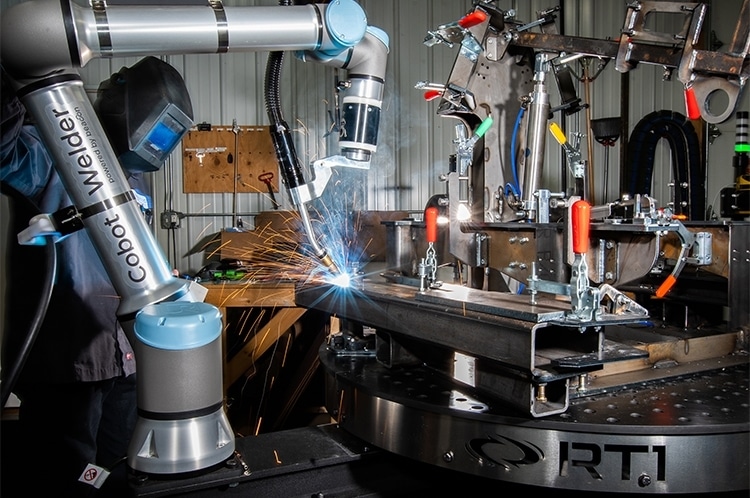
1. Properly Securing Products for Welding with Easy Removal
A good fixture must easily secure the product being welded and maintain its stability throughout the welding process. However, it should also facilitate easy removal of the product once the weld is complete. This balance is essential for maintaining production speed and minimizing downtime. Depending on the complexity and size of the welded pieces, different welding fixture clamping options—ranging from manual clamps to pneumatic or hydraulic systems—may need to be considered.
Additionally, the designer must also take into account the heat effects of the welding process on the finished part. These heat effects result in part sizes changing, unintentional part warping, or changes to the material (hardening or loss of hardening) properties due to heat.
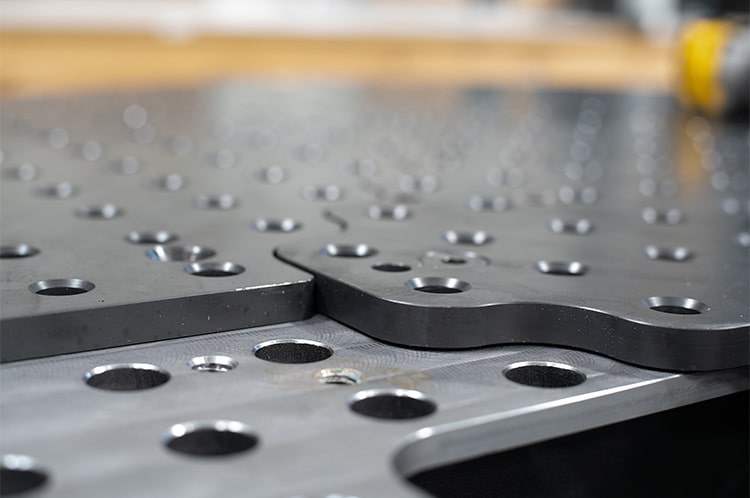
2. Wear Surfaces and Life Expectancy of Fixtures
Welding fixtures are subjected to intense conditions that can cause wear and tear over time. Therefore, it’s essential to fabricate fixtures with removable stops and easy-to-replace parts. Fixtures can last up to 50 years, so adding these features will prevent the need to replace the entire fixture when certain areas wear out.
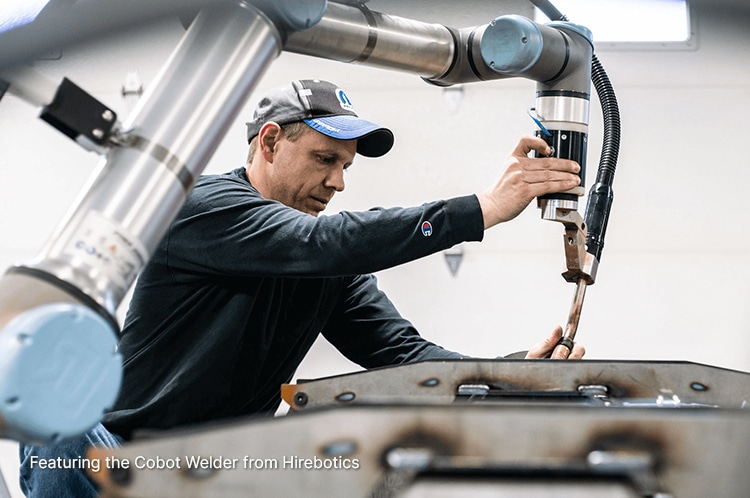
3. Fabrication with the Robot in Mind
Welding robots have specific ranges of movement, and the fixture must be designed to accommodate these limitations. It should be able to move or turn synchronously with the robot, especially for complex welds, to avoid contact with the robot arm. This requires careful design and planning, considering the full range of motion of the robot.
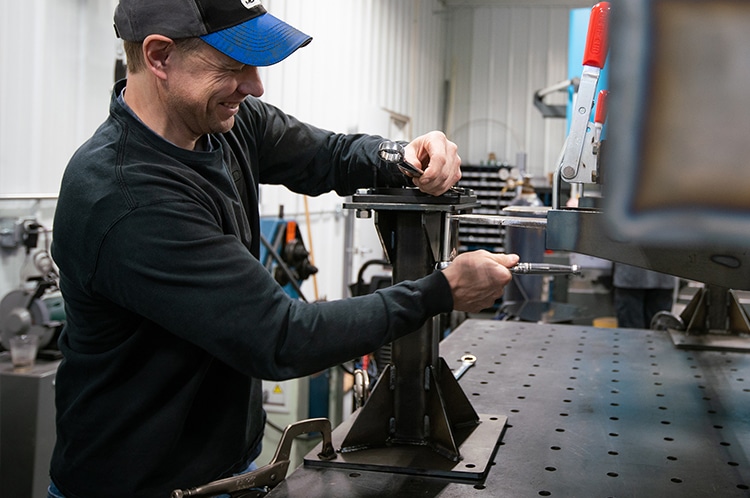
4. Grounding the Fixture
Proper grounding of the fixture is critical to prevent arcing, which could damage the fixture or the robot and even pose a safety risk. Grounding should be designed to not interfere with the movement of the fixture or the robot and maintain a consistent electrical connection throughout the welding process.

5. Center of Gravity & Dynamic Moment Loads
When designing a fixture, you must take into account the center of gravity and how it will change as components are added to the fixture. If the CG offset is too far off the centerline, the fixture can become dangerously offset and create incredible loads on the rotational axis.
If this is not carefully considered, the motor/gearbox cannot effectively move the part. The CG offset will create torque on the fixture that could cause accelerated wear or breakage that could injure the operator. If a positioner is required, the designer must incorporate the moment loads induced by the CG offset and the speed of rotation. If this is not considered, the welding fixture may not even operate once parts are loaded into it.
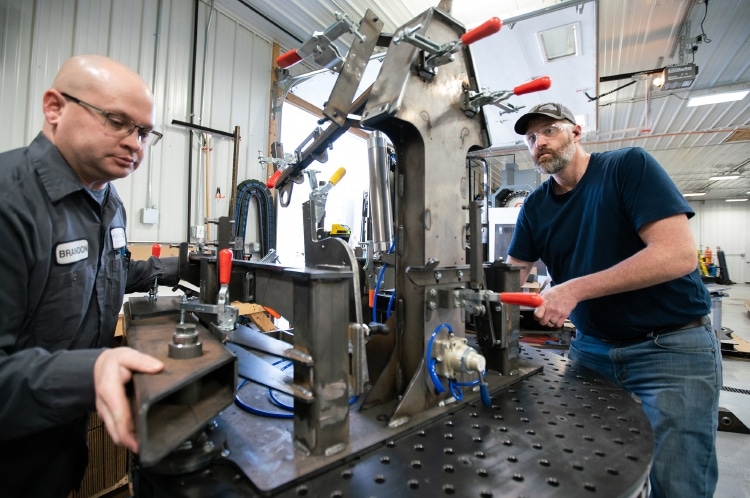
6. Safety
Above all, safety is paramount. Manufactured pieces can be heavy and difficult to handle, making the task of securing and reorienting them potentially dangerous.
- Fixtures and positioners must be designed to create a safer workspace.
- They should be easy to use, minimize the need for manual handling of the workpieces, and include features to protect the operator.
- If a part needs to be reorientated on the fixture, the positioner should make it easy and safe to do so.
Deciding on a Fixture Design Provider
Choosing a suitable contractor for your fixture design and needs can significantly influence the success of your robotic welding operations. This decision requires careful consideration of several factors.
Factors to Consider When Outsourcing Fixtures
Cost:
One of the most crucial considerations is cost. The provider should be able to offer a solution that fits within your budget without compromising on quality or functionality.
Expertise:
Choose a provider that specializes in designing fixtures for robotic welding. They should have the necessary knowledge and experience to design fixtures that meet your specific needs and can handle the rigors of your welding process.
Capacity:
The provider should have the resources and capacity to handle your requirements. They should be able to deliver your fixtures in quantity and within the timeline you require.
Time:
Building fixtures requires time for design and fabrication. Outsourcing this task lets you focus on your core operations while the provider handles the fixture design and fabrication.
Benefits of Outsourcing
Outsourcing our fixture design offers several benefits, such as
- Access to specialized expertise
- Get high-quality, tailored solutions
- Save time and resources
Kinetic Technologies specializes in designing fixtures for automation. With a strong track record in the industry, we provide the expertise and precision to cater to your specific fixture needs, no matter the difficulty. We also offer professional installation services to ensure the fixtures are properly integrated into your welding process.
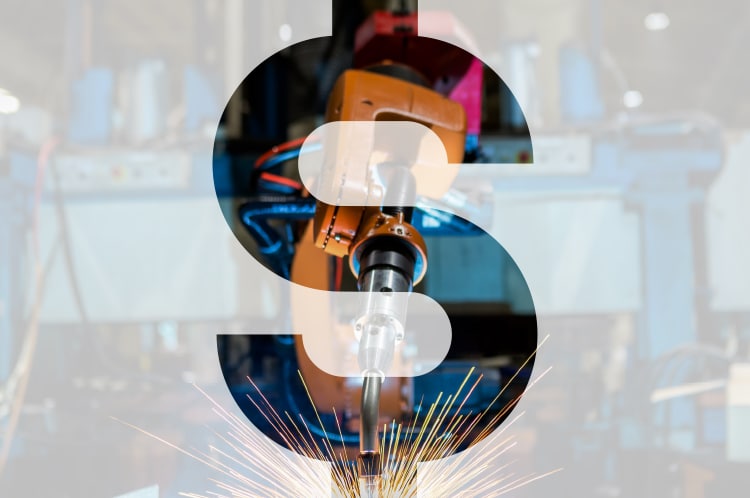
Robotic Welding Fixtures Costs & Considerations
Investing in robotic welding fixtures and positioners can involve more than just the upfront cost. It also encompasses development expenses, potential upgrade and adjustment costs, and maintenance and cost-efficiency analysis. Here’s a breakdown of these factors:
1. Initial Investment
Layout templates/jigs are simple, cost-effective solutions where the operator manually places and secures the workpiece in the fixture. They are typically used for simple weldments and low-volume production where high precision may not be a priority. However, these fixtures may not be suitable for complex weldments or high-volume production due to the potential for human error and slower processing times.
2. Cost of Development
If you choose to design and build fixtures in-house, you’ll need to account for design hours, materials, fabrication time, and testing. On the other hand, outsourcing your fixture design involves paying for the expertise and services of the design provider.
3. Upgrading and Adjustments
Fixtures not properly designed or manufactured may require modifications or upgrades, which can add to the overall cost. This is especially common when companies attempt to build quick, makeshift fixtures internally without fully considering all the factors required for true productivity and repeatability. A well-designed, high-quality fixture might require a higher initial investment, but it will save you money in the long run by minimizing the need for adjustments and maximizing operational efficiency.
4. Maintenance Costs
Like any equipment, fixtures and positioners require regular maintenance to function optimally. This could involve lubrication, replacement of worn-out parts, and general upkeep.
5. Cost-Efficiency Analysis
The ultimate cost of fixtures and positioners should be evaluated against the efficiency they bring to your operations. This includes increased welding speed, reduced rework, improved weld quality, and minimized downtime.
6. Potential Return on Investment
While the initial cost of high-quality fixtures and positioners may be high, the potential return on investment can be significant. By increasing productivity, reducing errors, and extending the life of your welding robots, these fixtures and positioners will more than pay for themselves over time.
Investing in high-quality fixtures and positioners can feel like a significant expenditure, but when viewed as a strategic investment in efficiency and quality, the benefits often far outweigh the costs. Work with a trusted provider to ensure you get the most value from your investment in robotic welding fixtures and positioners.
Conclusion
In this era of automation, robotic welding fixtures and positioners are beneficial and vital tools for welding robot owners, production managers, and manufacturing engineers. They provide the necessary stability and precision for robotic welding processes, ensuring the consistency and quality of the welds.
Harnessing the full potential of robotic welding fixtures and positioners can significantly boost productivity, often doubling production over manual labor. It’s an investment that can improve not only the speed and efficiency of your production processes but also the quality of the products you manufacture.
As the manufacturing industry continues to evolve and robotic welding becomes more prevalent, investing time, effort, and resources in understanding and implementing the right fixtures and positioners will continue to be an essential factor for success.
Discover What Welding Robot Owners Should Know About Robotic
Welding Fixtures & Positioners in our exclusive Ebook.
Closing Thoughts From Kinetic Technologies
At Kinetic Technologies, we understand the pivotal role that fixtures and positioners play in successful and efficient robotic welding operations. We leverage our experience and expertise in high-end product development and custom manufacturing to revolutionize your processes, delivering solutions that are tailor-made for your unique requirements.
Our team specializes in the design, fabrication, and installation of robotic welding fixtures and positioners. We recognize that each welding operation is unique, so we take the time to understand your specific needs and create solutions that optimize your processes, enhance quality, and boost productivity.
Working with Kinetic Technologies means partnering with a team committed to your success. We’re not just a provider; we’re a partner dedicated to helping you harness the full potential of your robotic welding operations. Let’s work together to transform your manufacturing process. With Kinetic Technologies, you’re not just improving your process; you’re investing in the future of your business.
